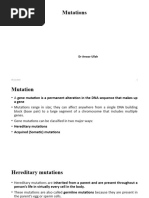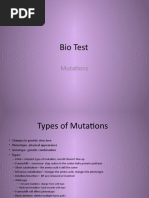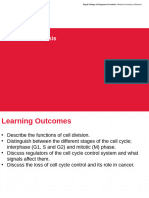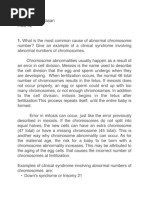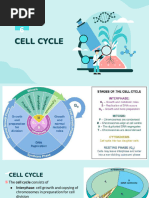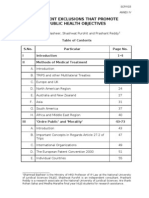Human Genetic Mutations: 2 Main Types of Mutations
Human Genetic Mutations: 2 Main Types of Mutations
Uploaded by
hasawanCopyright:
Available Formats
Human Genetic Mutations: 2 Main Types of Mutations
Human Genetic Mutations: 2 Main Types of Mutations
Uploaded by
hasawanOriginal Title
Copyright
Available Formats
Share this document
Did you find this document useful?
Is this content inappropriate?
Copyright:
Available Formats
Human Genetic Mutations: 2 Main Types of Mutations
Human Genetic Mutations: 2 Main Types of Mutations
Uploaded by
hasawanCopyright:
Available Formats
Human Genetic Mutations
2 Main Types of Mutations 1.) Chromosomal Mutations 2.) Gene Mutations What are chromosomes? Humans have 23 pairs of chromosomes, with one chromosome from each parent. The chromosomes are coiled up DNA. Under normal conditions all of the chromosomes are inherited in tact.
Chromosomal Mutations Any change in the structure or number of chromosomes Large scale: Affect many genes 5 Types 1. Deletion 2. Duplication 3. Inversion 4. Translocation 5. Non-Disjunction Chromosomal Deletion
A segment of genes is copied twice and added to the chromosome.
Causes : CharcotMarieTooth disease (high arched foot, claw feet, confined to a wheelchair) Chromosomal Duplication
A segment of genes is copied twice and added to the chromosome. Causes :CharcotMarieTooth disease (high arched foot, claw feet, confined to a wheelchair) Chromosomal Inversion
Causes : Four-Ring Syndrome (cleft pallate, club feet, testes dont descend) Chromosomal Translocation
Material is swapped with another chromosome Causes: Burkitts Lymphoma (cancer of the lymph nodes, in children) Nondisjunction Chromosomes FAIL TO SEPARATE during meiosis
Meiosis I Nondisjunction Meiosis II Nondisjunction Produces gametes (and therefore a baby) with one missing chromosome or one extra chromosome Nondisjunction (in Meiosis II)
Fertilization
Every cell in that babys body will have 3 copies of this chromosome instead of 2. This condition is called TRISOMY Trisomy 21 = Individual has 3 copies of chromosome # 21. Chromosomal Mutations Most chromosomal mutations are lethal If the fetus survives: Tend to cause wide-spread abnormalities Example: Down Syndrome Down Syndrome Cause: Nondisjunction of chromosome 21Three copies of chromosome 21 = TRISOMY 21 Trisomy 21 - Down Syndrome
Genetic Screening Amniocentesis
Gene Mutations Small scale: one gene is affected Any change to the DNA sequence of a gene:
Nucleotides/Bases may be added, missing, or changed Gene Mutations: 2 Types Point Mutation
Frameshift Mutation
Point Mutation One base (A, T, C, or G) is substituted for another Causes: Sickle-cell anemia 3 Possible Consequences: nonsense mutations: code for a stop, which can translate the protein missense mutations: code for a different amino acid silent mutations: code for the same amino acid Frameshift Mutation One or more bases (A, T, C, or G) are added or deleted Causes: Cystic Fibrosis Caused by: Insertion: adding a base Deletion: removing a base Causes of Mutations spontaneous
occur during DNA replication Caused by MUTAGENS physical, ex: radiation from UV rays, X-rays or extreme heat or chemical (molecules that misplace base pairs or disrupt the helical shape of DNA). Gene Mutations KEY IDEA: A mutated gene will make a mutated protein Mutant proteins are trouble! They do not go where they are supposed to go Example: Sickle Cell Anemia Normal Red Blood Cell Red blood cells shaped like a disc Hemoglobin (protien) carries oxygen to all parts of the body Sickle Red Blood Cell
Red blood cells form an abnormal crescent shape Hemoglobin (protein) is abnormally shaped don't move easily through your blood vessels
form clumps and get stuck in the blood vessels
SIGNAL TRANSDUCTION Cell-Cell Interactions For a coordinated function of cells in a tissue, tissues in an organ, organs in a system and systems in the body, cells need to be able to communicate with each other. Each cell should be capable of sending chemical signals to other cells and of receiving chemical signals from other cells, as well as signals (chemical or other) from its immediate environment. A cell can communicate signals to other cells in various ways. 1. Autocrine signaling 2. Paracrine signaling 3. Endocrine signaling 4. Direct signaling 5. Synaptic signaling Autocrine signaling is a way for a cell to alter its own extracellular environment, which in turn affects the way the cell functions. The cell secretes chemicals outside of its membrane and the presence of those chemicals on the outside modifies the behavior of that same cell. This process is important for growth. Paracrine signaling Is a way for a cell to affect the behavior of neighboring cells by secreting chemicals into the common intercellular space. This is an important process during embryonic development.
Endocrine signaling utilizes hormones. A cell secretes chemicals into the bloodstream. Those chemicals affect the behavior of distant target cells. Direct signaling is a transfer of ions or small molecules from one cell to its neighbor through pores in the membrane. Those pores are built out of membrane proteins and are called gap junctions. This is the fastest mode of cell-cell communication and is found in places where extremely fast and well-coordinated activity of cells in needed. An example of this process can be found in the heart. The muscle cells in the heart communicate with each other via gap junctions which allows all heart cells to contract almost simultaneously.
Synaptic signaling is found in the nervous system. It is a highly specific and localized type of paracrine signaling between two nerve cells or between a nerve cell and a muscle cell.
Target cells
Specific cells are affected by hormone and respond in unique fashion: Cells have specific receptors on membrane or in cell that respond to hormone Can have receptors for several different hormones Number of active receptors can change Down-regulation - number of receptors decreases & target is less sensitive Up-regulation- number increases & target is more sensitive How does a cell receive a signal? Some small molecules are capable of entering the cell through the plasma membrane. Some small hormones also enter the cell directly, by passing through the membrane. Examples are steroid hormones and thyroid hormones.
You might also like
- S18e - 1 10 2014Document300 pagesS18e - 1 10 2014Iuliana Maria100% (1)
- Natural Healing Through MacrobioticDocument192 pagesNatural Healing Through MacrobioticGalina100% (1)
- Zhou Jian-2Document82 pagesZhou Jian-2runcorn100% (2)
- Genetic and Chromosomal MutationsDocument38 pagesGenetic and Chromosomal MutationsyuenkeithNo ratings yet
- MutationDocument39 pagesMutationJanet BarcimoNo ratings yet
- Errors and Exceptions in Chromosomal InheritanceDocument34 pagesErrors and Exceptions in Chromosomal InheritanceponnambhuviNo ratings yet
- GeneDocument162 pagesGeneMunewer AbdellaNo ratings yet
- Dna Mutation and Its Effect On IndividualDocument7 pagesDna Mutation and Its Effect On IndividualFaye ViernesNo ratings yet
- Types of MutationsDocument64 pagesTypes of MutationsI'm Cracked100% (1)
- 3 MutationsDocument31 pages3 Mutationsmerzi farooq ahmadkhanNo ratings yet
- MUTATIONDocument30 pagesMUTATIONbam yeontanieNo ratings yet
- Genetics by TGDocument53 pagesGenetics by TGrubypath2017No ratings yet
- Chapter 3.3 Chromosomal MutationDocument35 pagesChapter 3.3 Chromosomal MutationaboodNo ratings yet
- Science (Mutation) G10Document39 pagesScience (Mutation) G10Ynna WritesNo ratings yet
- GeneticsDocument87 pagesGeneticstiaria.wilson24No ratings yet
- Chapter 6 Form 5 VariationDocument47 pagesChapter 6 Form 5 VariationSivam DhanabalNo ratings yet
- Chap4 Mutation 120919212945 Phpapp02Document85 pagesChap4 Mutation 120919212945 Phpapp02Rxjviie BodaNo ratings yet
- EmbryologyII (19)Document57 pagesEmbryologyII (19)abaya.marga-ugNo ratings yet
- 9-10 - Variations to Mendels LawDocument27 pages9-10 - Variations to Mendels Lawjenereijarsemubag-idNo ratings yet
- Cell DivisionDocument53 pagesCell DivisionirishninamadayagNo ratings yet
- Genetic 3Document37 pagesGenetic 3MohammedNo ratings yet
- GENETICSDocument23 pagesGENETICSKea GuirreNo ratings yet
- Genetic Disorders 1Document30 pagesGenetic Disorders 1Homed OpriNo ratings yet
- Unit 3Document58 pagesUnit 3mishtydprNo ratings yet
- Topic4 GeneticsDocument34 pagesTopic4 Geneticsummi zNo ratings yet
- Chapter 4 Quiz NotesDocument7 pagesChapter 4 Quiz Noteschisomamadi81No ratings yet
- 1 Mutations Power PointDocument11 pages1 Mutations Power PointAngie Nicole QuerubinNo ratings yet
- Cell Cycle and Cell Divison and Cell DeathDocument90 pagesCell Cycle and Cell Divison and Cell DeathPACS PRPNo ratings yet
- MutationDocument45 pagesMutationVenice Laureign AgarpaoNo ratings yet
- 4 2-MutationDocument26 pages4 2-Mutationcabilesrobilyn479No ratings yet
- Science 10 Group 7 ReportDocument19 pagesScience 10 Group 7 ReporthannahkathryllvalenciaNo ratings yet
- LSM2107 Lect 4 How Do Variations Come About?Document80 pagesLSM2107 Lect 4 How Do Variations Come About?Hey byeNo ratings yet
- Bio Test MutationsDocument23 pagesBio Test MutationsShoshanna NatanyaNo ratings yet
- Genetic Disorders 091448Document13 pagesGenetic Disorders 091448pespes20111No ratings yet
- MCP 02.11 MitosisDocument31 pagesMCP 02.11 MitosisMohamad DarazyNo ratings yet
- mubDocument7 pagesmubms4926489No ratings yet
- Cell biology class notesDocument5 pagesCell biology class notesANJANANo ratings yet
- Genetics and MutationsDocument63 pagesGenetics and MutationsEmaan NoorNo ratings yet
- Cell Cycle and Cancer (2)Document29 pagesCell Cycle and Cancer (2)laura.burckhardt9No ratings yet
- Lecture 4 Cell Division Mitosis and CancerDocument74 pagesLecture 4 Cell Division Mitosis and CancerGerald AdolfoNo ratings yet
- Module Mol Chapter 7Document78 pagesModule Mol Chapter 7eyoelNo ratings yet
- Genetic and ChromosomesDocument16 pagesGenetic and ChromosomesJay PornelaNo ratings yet
- GENTICSDocument13 pagesGENTICSsc.linkshortener.1No ratings yet
- Part 1 NotesDocument22 pagesPart 1 Notesapi-299641879No ratings yet
- lecture 3 (1)Document43 pageslecture 3 (1)mohamedibrahimmagdy2005No ratings yet
- What Is The Most Common Cause of Abnormal ChromosomeDocument4 pagesWhat Is The Most Common Cause of Abnormal ChromosomemaryNo ratings yet
- Meiosis and Sexual Reproduction Review SheetDocument5 pagesMeiosis and Sexual Reproduction Review SheetKen PulmonesNo ratings yet
- Heredity and Variation IDocument21 pagesHeredity and Variation Ismbdy tbhhhNo ratings yet
- D2.1 Cell and Nuclear DivisionDocument54 pagesD2.1 Cell and Nuclear DivisionFarah HusynNo ratings yet
- Gentics Pathology Lec.1Document23 pagesGentics Pathology Lec.1gmpcbpzdysNo ratings yet
- Biomedical Basis of Disease NotesDocument20 pagesBiomedical Basis of Disease Notesteganswann2004No ratings yet
- MutationsDocument30 pagesMutationsjyothi sai sriNo ratings yet
- Copy of 24-25 Cell Cycle (4.6-4.7)Document51 pagesCopy of 24-25 Cell Cycle (4.6-4.7)hacker.pro123.gamerNo ratings yet
- Intro To GeneticsDocument30 pagesIntro To Geneticssami ullahNo ratings yet
- Lecture 22.the Lowdown On GeneticsDocument28 pagesLecture 22.the Lowdown On Geneticsqanitakhan2002No ratings yet
- 13 ChromosomesDocument36 pages13 ChromosomesKiki QqsNo ratings yet
- Cell Division in ProkaryotesDocument30 pagesCell Division in ProkaryotesArianne ValenzuelaNo ratings yet
- Cell CycleDocument31 pagesCell Cyclemyra.cardonaNo ratings yet
- Chromosomal Defects - EditedDocument35 pagesChromosomal Defects - Edited2ktgs69f6mNo ratings yet
- 1-Genome Organization and Structure of DNA - Sevgi GeziciDocument98 pages1-Genome Organization and Structure of DNA - Sevgi Gezicimmradd9999No ratings yet
- Terapi Gen - Pertemuan 2Document39 pagesTerapi Gen - Pertemuan 2fifilalasari24No ratings yet
- 6. Chromosomal VariationsDocument16 pages6. Chromosomal Variationskhatunreya2kNo ratings yet
- Fast Facts: Leukemia: From initial gene mutation to survivorship supportFrom EverandFast Facts: Leukemia: From initial gene mutation to survivorship supportNo ratings yet
- LEAM ProtocolDocument6 pagesLEAM ProtocolShaza ElkourashyNo ratings yet
- 3RD PerioDocument8 pages3RD PerioAce Vincent LunaNo ratings yet
- Valencia Soto Et Al 2023 Severe Hepatotoxicity During Treatment With CapmatinibDocument5 pagesValencia Soto Et Al 2023 Severe Hepatotoxicity During Treatment With CapmatinibCinantya Meyta SariNo ratings yet
- Challenging Clinical Scenarios of The BreastDocument62 pagesChallenging Clinical Scenarios of The BreastMuhammad HassanNo ratings yet
- FIGO Staging Revisions 2009Document2 pagesFIGO Staging Revisions 2009Tania Widya EkayantiNo ratings yet
- FiberDocument5 pagesFiberapi-366449205No ratings yet
- UTZDocument12 pagesUTZIyah Bu-ucanNo ratings yet
- Viii - Diagnostics Date Procedure Description Purpose/ Significance Normal Ranges Result Indication/Impr EssionDocument9 pagesViii - Diagnostics Date Procedure Description Purpose/ Significance Normal Ranges Result Indication/Impr EssionChristian Karl B. LlanesNo ratings yet
- Science 9 TG Draft 4.29.2014Document406 pagesScience 9 TG Draft 4.29.2014astherielleNo ratings yet
- Gannguan PubertasDocument56 pagesGannguan PubertasAde Yosdi PutraNo ratings yet
- Medcan - WP - The Blueprint To Transform Your Employee Health Strategy - 09.2024Document12 pagesMedcan - WP - The Blueprint To Transform Your Employee Health Strategy - 09.2024johnsonshelly499No ratings yet
- Instant ebooks textbook Flow Cytometry in Neoplastic Hematology Morphologic Immunophenotypic Genetic Correlation 4th Edition Wojciech Gorczyca download all chaptersDocument81 pagesInstant ebooks textbook Flow Cytometry in Neoplastic Hematology Morphologic Immunophenotypic Genetic Correlation 4th Edition Wojciech Gorczyca download all chaptersreberfoladi100% (4)
- Grade 8 HEALTH Q4 Lesson2 LM AlcoholDocument29 pagesGrade 8 HEALTH Q4 Lesson2 LM Alcoholleomille280% (10)
- Health Approach To Albularyo Hilots and HealersDocument25 pagesHealth Approach To Albularyo Hilots and HealersFrancis Dela CruzNo ratings yet
- Blood Work Results 11.15Document4 pagesBlood Work Results 11.15Anonymous OdYvCTXNo ratings yet
- Albayrak 2016Document7 pagesAlbayrak 2016DavorIvanićNo ratings yet
- Important National and International DaysDocument17 pagesImportant National and International DaysGopal KrishnaNo ratings yet
- Wcet2016 Programme and Abstract BookDocument64 pagesWcet2016 Programme and Abstract BookMohyuddin A MaroofNo ratings yet
- Influence of Mass Media Campaigns On Breast Cancer Knowledge Among Women in Enugu StateDocument28 pagesInfluence of Mass Media Campaigns On Breast Cancer Knowledge Among Women in Enugu Statesofia mubasherNo ratings yet
- 200 Articles Ebook Thecureforcancer-Min PDFDocument439 pages200 Articles Ebook Thecureforcancer-Min PDFVictor DaetNo ratings yet
- Health Assessment Lecture NotesDocument40 pagesHealth Assessment Lecture Notesmrudisill10100% (2)
- Treatment Couch Transmission Factor CalculationDocument12 pagesTreatment Couch Transmission Factor Calculationapi-334644774No ratings yet
- SCP 15 3-Annex4Document84 pagesSCP 15 3-Annex4Hasan HaxhajNo ratings yet
- Standard LFT and It's Clinical SignificanceDocument28 pagesStandard LFT and It's Clinical SignificanceanimathzNo ratings yet
- CSR Project-Initiatives and BudgetDocument5 pagesCSR Project-Initiatives and BudgetShreya GuptaNo ratings yet
- Nurc Gastrointestinal Hepatobiliary & Neurological Nursing: Masmunaa Hassan 19 September 2017Document29 pagesNurc Gastrointestinal Hepatobiliary & Neurological Nursing: Masmunaa Hassan 19 September 2017Jakub KubaNo ratings yet
- Barfoed Reagent: Material Safety Data SheetDocument4 pagesBarfoed Reagent: Material Safety Data SheetEkaTiyasAnggraeniNo ratings yet









